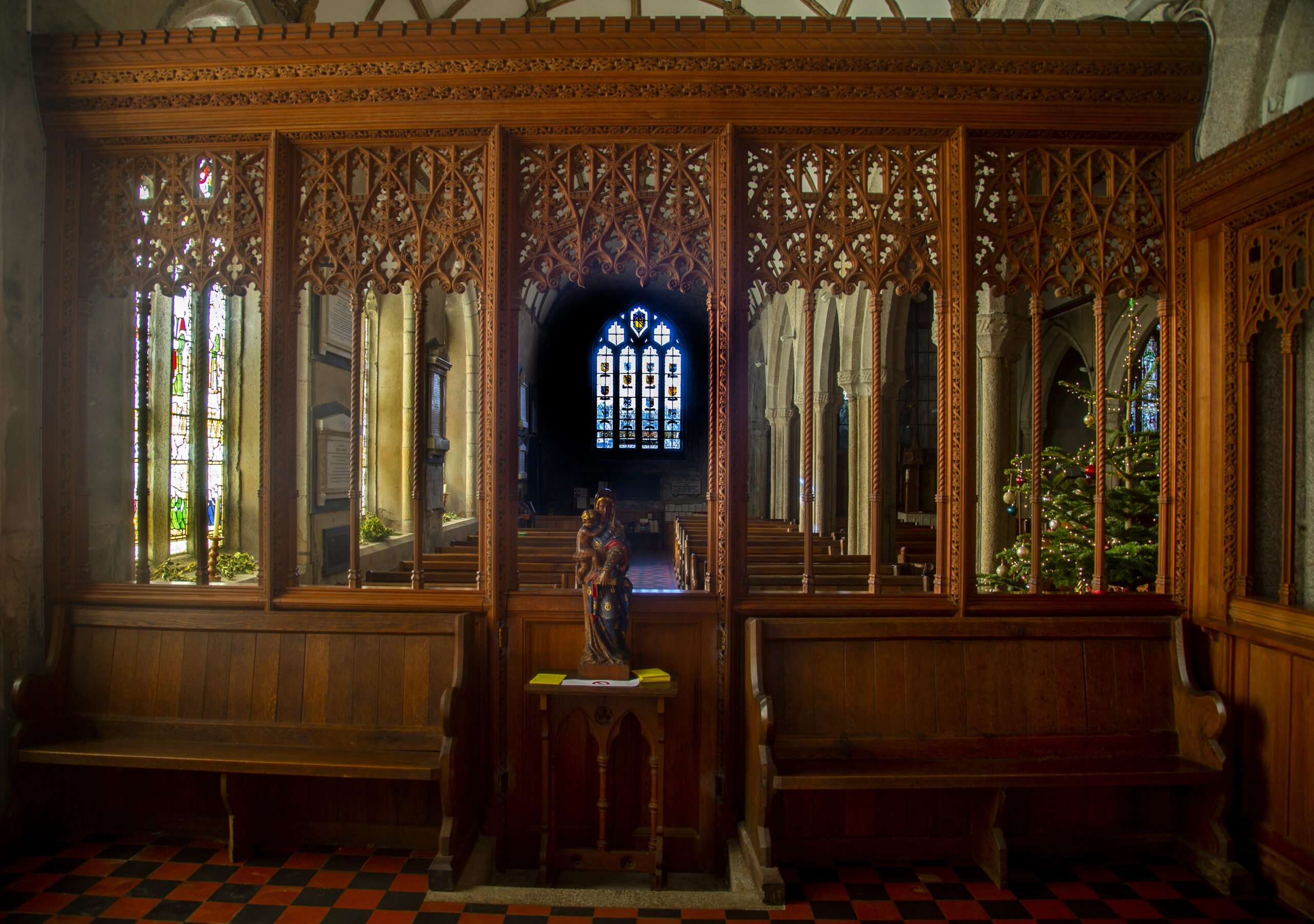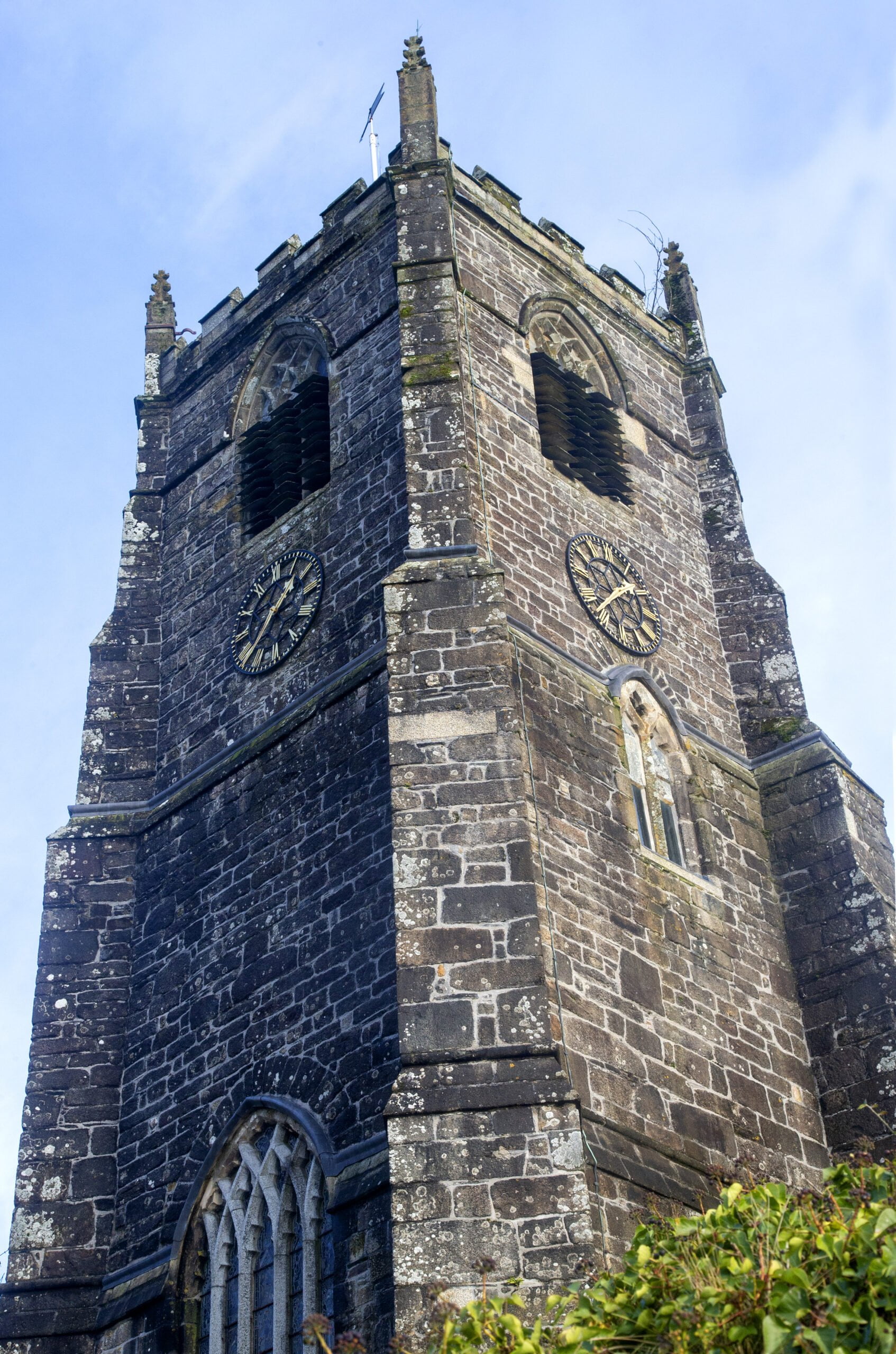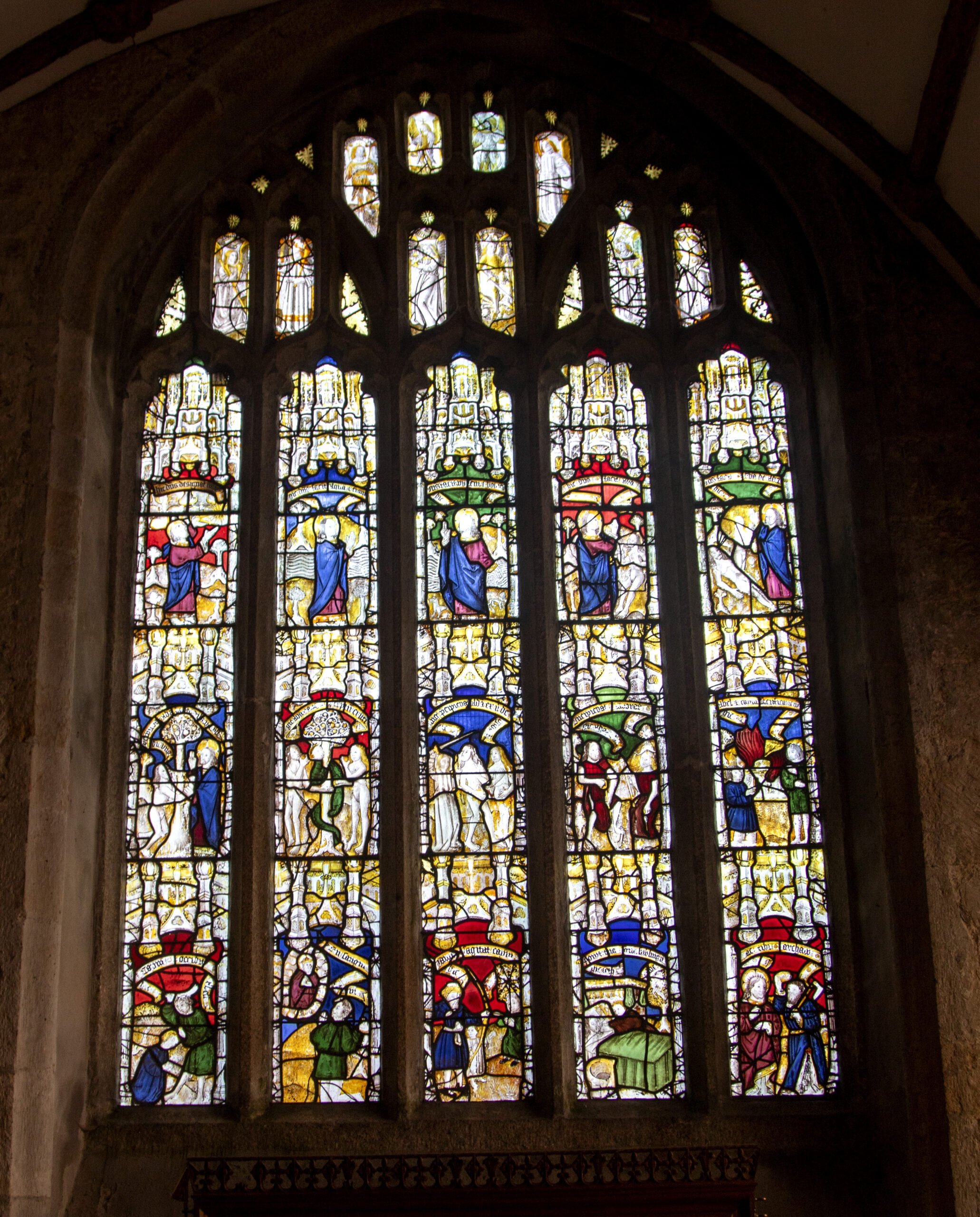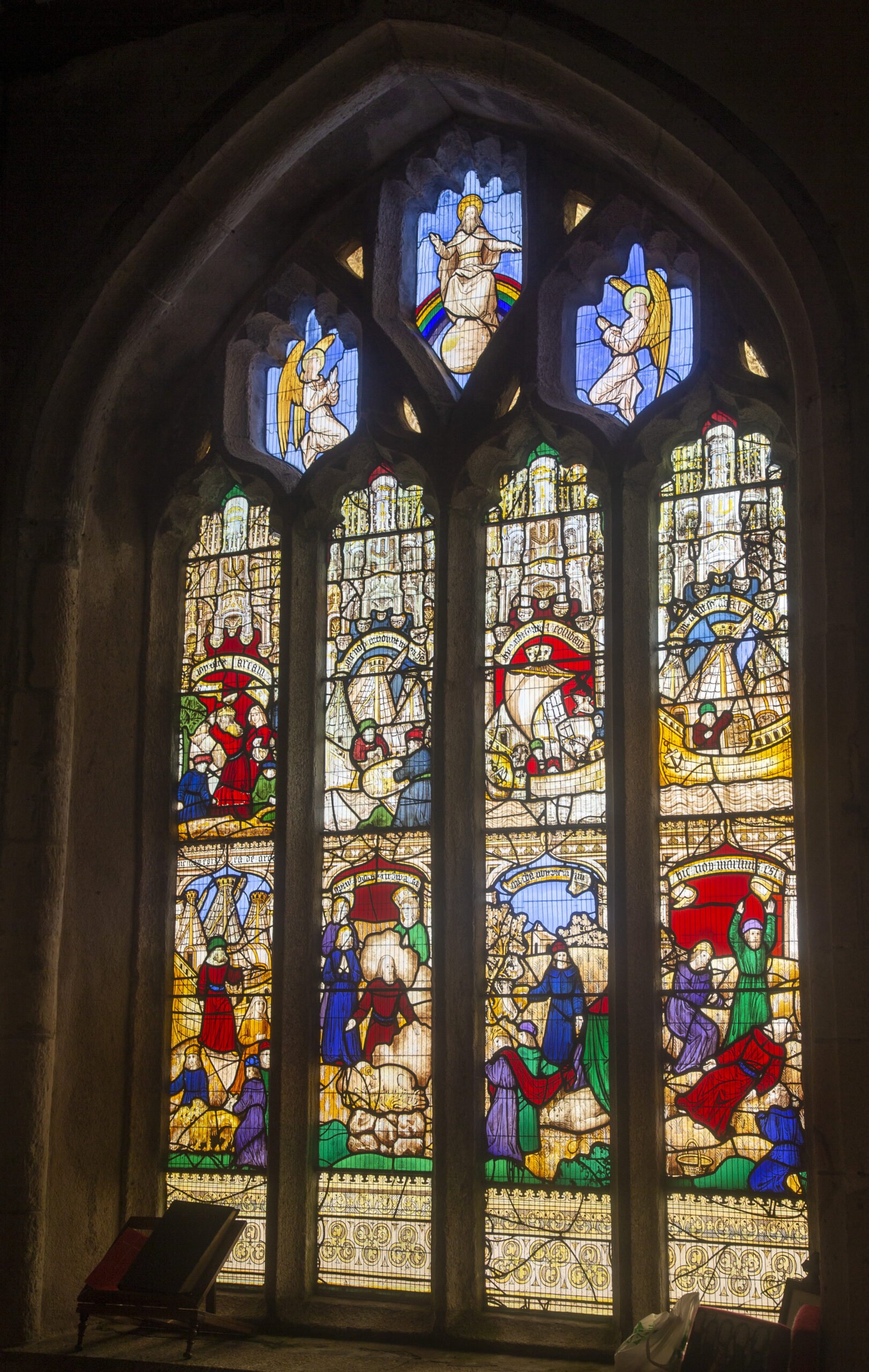The present church at St. Neot was built about 1425 but was not finished in its final form until late in the 15th century when the north aisle was added. The position of the church is outstanding. It dominates the village, and the southern aspect – the side seen from the village – is a fine piece of architecture with the buttresses between the windows rising to pinnacles which extend above the parapet of the roof.

The porch of the main door has an upper storey, which is an unusual feature. A vaulted ceiling in the ringing chamber is the only one in the county. The glory of the church is its stained and painted glass which dates from the early 16th century. Visitors from all over the world come to see the work of designer Robert Tubbe, Vicar of St. Neot from 1508-1544. Today, the finest and least restored window, is the Creation Window, at the east end of the south aisle. Robert Tubbe ran out of funds before he could complete the work and appealed to the wealthy families of the parish but even this was not sufficient. Groups of people got together to finish the work – the wives, young women and the young men provided for three.
The young men paid for the St. Neot window in the north aisle which depicts many of the legends of the saint. He can be seen reading the psalter with his feet in the holy well; protecting a doe from a hunter; being told by an angel that if he only takes one of the three fishes in the holy well each day for his food there would always be three there again in the morning; admonishing his servant for cooking two when he was ill and ordering him to put them back whereupon they came to life; and Neot kneeling to receive the blessing of Pope Martin. The Creation Window presents the Creation, the Fall and the story of Cain and Abel. It is a joy, giving those with time a great feast of delight – God with his dividers planning the universe: the smug look on Eve’s face as she receives the apple and in contrast her look of despair as she is driven out of paradise. An unusual picture showing Seth placing seeds in the dying Adam’s mouth represents a legend familiar to Cornish folk at the time the windows were made. It is said that from those seeds trees would grow which would eventually provide wood for the cross. This was dramatised in the Ordinalia – the cycle of religious plays in the Cornish language written in Glasney in the 15th century. The last picture shows Noah, axe on shoulder, doffing his cap to God as he receives his instructions for building the ark – the subject of the adjoining window. The ark is usually depicted in church windows in the form of the children’s toy but here it appears as a three-masted ship that might have sailed the seas at that period. The provisioning of the ark includes a large barrel going abroad, reminding one of the G.K. Chesterton’s poem…
I do not care where the water goes
If it doesn’t get into the wine.
Most of the features of the story of Noah are here -the raven, the dove, disembarkation, the story of Noah’s drunkenness and his death. To stand or sit in this corner of the church with the sun blazing in, these two windows have a beauty which is quite unforgettable. The west window in the north aisle is of unique interest because some of the incidents depicted are not found anywhere else and because of the gruesome details found there. This is the St. George window which portrays twelve scenes from the legendary history of the saint. Three of the windows are later, being designed by John Hedgeland in 1830 during restoration work ordered by the patron of the church and former vicar Revd. Richard Gervays Grylls at a cost of £2000.

These include the east window over the high altar and the two in the organ chamber. The list of the vicars is complete from 1266 as can be seen on the boards hanging in the north aisle. The parish is now joined with its neighbour Warleggan under the present vicar. One of the vicars who served for five years in the mid 16th century – Richard Bennett was executed for joining the Cornish Rebellion of 1549. Another vicar, Joseph May combined St. Neot with St. Austell and was eventually ejected from both, having been accused and tried for the murder of his lady friend of the day. By some means he got off (like many vicars of that time he was probably very rich.) In 1313, the vicar Sir Philip became a leper, and the Bishop of Exeter appointed a replacement to carry out the parish duties and ordered that a room should be provided in the parsonage. The “Father” Willis organ was presented to the church in 1884. It is a two-manual with a pedal board. It was built at a cost of £400. Henry Willis (known as “Father” to distinguish him from his organ-builder son) was the builder of the organs at the Royal Albert Hall, Canterbury, and Truro Cathedrals.

At the west end of the north aisle, beneath the St. George window, is a very fine early 17th century slate tomb chest on which the kneeling figures of William Bere and his wife are carved in bold relief. The slate for this memorial and many of the headstones in the churchyard were mined in the parish at Carnglaze which is now open to the public. High on the north wall at the east end of the church is a copy of the letter written by King Charles from his castle at Sudeley on 10th September 1643, to the inhabitants of Cornwall thanking them for their loyalty and support and commanding it to be read in every church and chapel in the county and to be kept forever as a record of the same. St. Neot, despite its remote position, felt the effects of the Civil War. The battle of Braddock Down in January 1643 was fought only four miles away and there was much activity in the neighbourhood during the Lostwithiel campaign. Much damage was done to the vicarage during this time as Thomas Philpe, the vicar at the time, wrote. He gives a dismal tale of the burning of rafters and other timber “both of the dwelling house and outhouses, taking away the glass and iron bars of the windows soe that all was near total devastation so that the incumbent was necessitated to betake himself forthwith to building if he would have any house to put his head in.” Certainly, St. Neot is Royalist and every year on Oak Apple Day, 29th May, an oak branch is set at the top of the tower. The day is marked with due ceremony. The oak branch is carried in procession through the village followed by a large crowd all wearing oak leaves in their buttonholes. The old branch is thrown down and the ringers and churchwardens haul the new branch to the top. Prayers are said and three cheers called for the new branch. The canopied recess on the north side of the Sanctuary is popularly supposed to have contained the shrine of St. Neot, but it is more likely to have been an Easter Sepulchre. Within it are faint traces of a mural painting. Among the modern features of the church are the Screen dated 1902, the pulpit, and the unique set of kneelers designed and made by the people of the parish. Above all, this is not just a very beautiful church, it is “the living centre of worship in St. Neot.”

Cornishman and publisher Len Truran who is no longer with us


